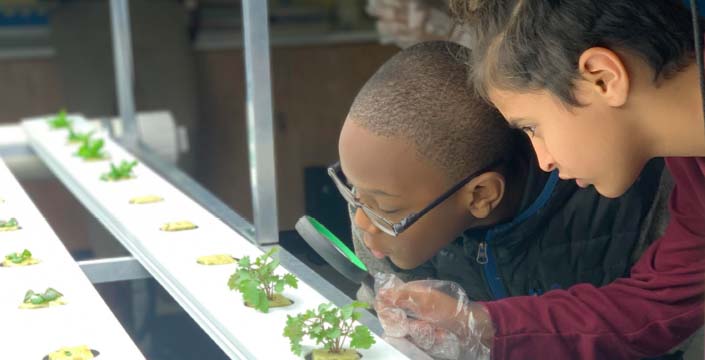Thinker's Notebook
Tackling The Green Divide

Thinker’s Notebook
By Marlon Rice
Every other Wednesday and Friday, I teach Urban Ecology at PS 81 on Dekalb Avenue in Bed-Stuy. A couple of years ago, the school was gifted an entire Hydroponics lab. In September a friend of mine, Earl Silas, introduced me to Principal LaTrace Finney.
Principal Finney is a pioneer, a change-agent, the type of leader that is results-oriented and who leads with love. She wanted to get the lab up and running because she knew that it would impact the entire educational experience for her children. I agreed to partner with Principal Finney to make that happen, because I believe the same.
We are currently growing cilantro, lettuce, cucumbers, kale and green peas in our lab. The 4th and 5th graders are engaged in the entire process. So far, we’ve discussed a variety of fruits and vegetables, we’ve discussed the life cycle of a plant and we have begun the process of measuring our sprouts to analyze growth. The kids enjoy the class. They are excited to be owners of plants that will eventually yield vegetables. Every day they ask when the vegetables will grow. So, we also teach the art of patience.
The statistics prove that pollution and other environmental issues affect the Black community disproportionately. Blacks are generally exposed to greater health risks, both at work and in their neighborhoods. This summer, I worked with NASA and City Tech to analyze surface temperatures in Bed-Stuy. The goal of the analysis was to find ways to combat the urban heat island effect. An urban heat island is an urban area where the surface temperatures are elevated due to the modification of land surfaces. More concrete and asphalt means higher surface temperatures. As such, inner cities that have more concrete buildings tend to exhibit urban heat island effect. The ramifications of elevated surface temperatures are increased air pollution, respiratory difficulties and other heat-related mortalities.
Although our communities are more adversely affected by environmental issues, Blacks are less likely to be a part of green initiatives or any environmental advocacy. For example, although Blacks make up 13% of the population, they only comprise 5.5% of the solar industry workforce, and less than 2% of the general energy workforce. According to the American Association of Blacks in Energy, although Blacks spend over $40 Billion per year on energy, they receive less than .01 percent of the revenue from the energy industry.
How do we activate diversity inclusion with regards to the Green industry? Well, it starts by making green-oriented curriculums available to Black and Brown children living in inner cities as early as possible. Children make decisions about their future based on the data presented to them. And like the old saying goes, they don’t know what they don’t know. In our inner cities, specifically in metropolitan regions, a working knowledge of agriculture is narrowed by terrain.
I grew up with a garden in my backyard, but I have friends that never grew a plant until they were adults. So, curriculums and workshops added to the early elementary experience are so important when it comes to offering the brilliant mind of a child the chance to learn to love ecology, or horticulture, or botany, or solar energy. This isn’t an introduction though, as much as it is a re-introduction. For those of us that are products of the myriad of Black Diasporas that brought us to this point, we can all trace our lineage back and realize that not too long ago our grandparents, or even in some cases our parents were raised in the South, or in the Caribbean, or in South America on farms or with gardens, raised up in a time when a knowledge of agriculture was a vital part of our existence. Even subtle occurrences, like your grandma making you snap fresh green beans so that she could cook them, that’s the kinds of lessons that used to inspire connections.
If we want to have a seat at the Green industry table, we need to realize that it is our culture that built the very table that now serves as support to those that have finally, after decades of destroying our ecosystems, found methods to commodify terms like sustainability and green. And then, we need to teach our children the terms and processes early, so that they may come to love a relationship with Mother Earth.
Marlon Rice is the Executive Director of the Magnolia Tree Earth Center of Bedford Stuyvesant, Inc.


